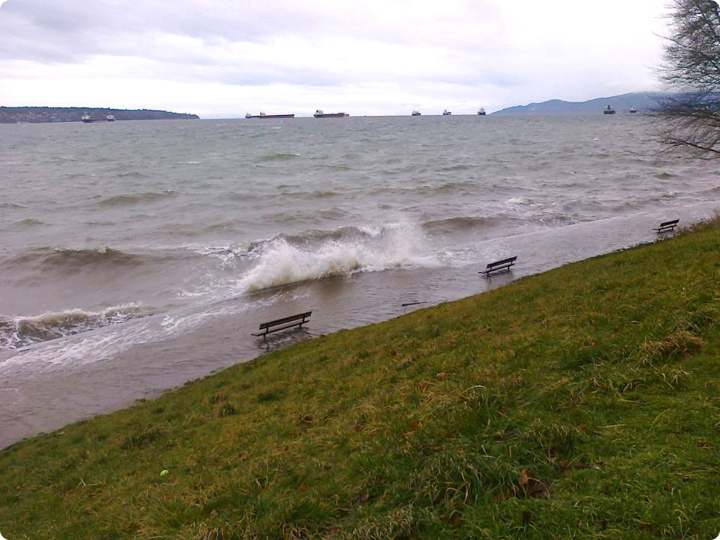The effects of climate change are already being felt in B.C. As climate change progresses, we will see increasing impacts on water resources, ecosystems and landscapes of our province. These changes will, in turn, affect our communities, infrastructure, industries, agriculture and recreational opportunities.
Being prepared for climate change means we will need to adapt to climate impacts over time. This will require us to plan ahead for long-term changes, like disappearing glaciers, and to respond to increased variability in seasonal weather patterns, including more frequent droughts and floods.
How will climate change affect water in B.C.?
B.C.’s mountainous terrain and varied landscapes mean that climate change will affect hydrological regimes and water use patterns differently across the province.
Compared to average historical conditions (1961-1990), by the middle of the century (2041-2070), B.C. is expected to become warmer and wetter, with higher annual average temperatures and precipitation.1 While B.C. will become wetter overall, precipitation will not occur evenly throughout the year. Fall, winter and spring are projected to be warmer and wetter with more rain and less snow, particularly at lower elevations. Summers will be hotter with reduced precipitation in most areas.
Watersheds will respond to these changes in different ways depending on their characteristics. For example, in coastal watersheds (e.g., Campbell River) that are both snow- and rain-fed, declining snowpack is expected to cause the flow regime to shift toward being predominantly rain-fed. This will result in higher stream flow during the fall and winter and lower stream flow during the spring and summer.2
Interior snow-fed watersheds (e.g., Peace River) will see more rain during fall, winter and spring, resulting in increased fall and winter discharge. Warmer spring temperatures will cause the freshet to begin earlier. Combined with warmer summers, this will result in reduced stream flow in summer and early fall.
In coastal areas, sea level rise and storm surges will increase flood risks and threats to human health, safety, and property. Estimates of mean sea level rise by 2100 for the B.C. coast range from 80 cm at Nanaimo to 120 cm in the Fraser Delta.
 Figure 1: Some parts of the BC coast already experience flooding during seasonal high tides, or King Tides. The sea wall
Figure 1: Some parts of the BC coast already experience flooding during seasonal high tides, or King Tides. The sea wall
in English Bay was flooded during a high tide-storm surge event on December 17, 2012. Photo by Lisa Brideau.
Climate change is also expected to cause weather patterns to become more variable. Hydrological extremes such as droughts and heavy rainfall events may become more intense and/or more frequent in the future.
Given these expected changes, new tools will be needed to manage for both long-term changes and increases in year-to-year variability in the water cycle.
Developing new approaches to water management
Preparing for a changing climate is a key theme in Living Water Smart. Living Water Smart commits that …new approaches to water management will address the impacts from a changing water cycle, increased drought risk and other impacts on water caused by climate change.
Through Living Water Smart the B.C. government is committing to many new actions that will enable B.C. to adapt to climate change, and create liveable communities. These include:
- Modernizing our water laws to improve water allocation and better protect ecosystems;
- Using water more efficiently so we can be better prepared for increased variability in water supplies due to climate change;
- Planning with water in mind to promote innovation and creativity related to how we design and build communities, new buildings and infrastructure;
- Developing new design guidelines for buildings in flood prone areas and for flood protection infrastructure to account for increasing flood risk.
Preparing for droughts
Drought is a recurrent feature of climate involving a deficiency of precipitation over an extended period of time, resulting in a water shortage. In British Columbia, drought may be caused by combinations of insufficient snow accumulation, hot and dry weather or a delay in rainfall.
How does drought affect B.C.?
Drought conditions can impact communities and individuals in many different ways. Previous droughts, including that experienced in southern B.C. in 2009, highlight the importance of having clear actions and strategies to manage water in times of drought for both water users and aquatic ecosystems.
Being prepared to respond to droughts when they occur will help communities manage water for drinking, sanitation, fire protection, agriculture and other economic activities. It will also help protect fish and aquatic ecosystems.
Check out B.C.’s drought response plan that builds on existing tools and outlines the actions taken during and immediately following a drought to reduce its impacts. http://www.livingwatersmart.ca/drought/response.html


 Figure 1: Some parts of the BC coast already experience flooding during seasonal high tides, or King Tides. The sea wall
Figure 1: Some parts of the BC coast already experience flooding during seasonal high tides, or King Tides. The sea wall